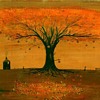Posted 13 years ago
 ericevans2
ericevans2
(52 items)
Thornton-Pickard | "Royal Favorite". | 1909. | Field Camera. | Half Plate.
Catalogue No.0213.
Labelled "Thornton-Pickard Ld. "Royal Favorite" Made for Harrington & Co. Ld. Australia.", this must have travelled from Britain to Australia and back again to Norfolk, UK, where I bought it, and confirms the fact that T-P made for Harringtons. It appears to be a high class version of what they called in Britain, "The Imperial Perfecta", with extra brass trim and a geared rising front. It has the "Three Bar Front", consisting of three brass reinforcing strips, introduced in 1909.





















Thanks for the "Loves". I have put a lot of love into all of them.
Hi, this is a gorgeous item. What is a field camera? Thanks.
You have a beautiful collection....:-)
Thanks for your kind comments. A field camera is a camera that can be used "in the field", ie outdoors, as opposed to only in a studio.
Sorry to be so late this terrific piece.
Was it used to take outdoor portraits, landscapes, or both? And it must have weighed a ton, right? Thanks for sharing!
Hi Belltown, Men had muscles in those days; I have cameras larger than this one equipped with buttons to take a neck-strap. If you wanted a landscape, you had to take the camera to the landscape, and many did!
Hi Belltown - adding to Eric's comments; this is specifically a field camera in what is known to collectors as an "English Compact" body pattern. In this case, 'field' implies something that is portable and transported outside of a studio. Different lenses allowed the photographer to shoot many types of pictures (i.e. portraits, landscapes, etc.). The camera also has 'tilt' movements, which allow it to be used for architectural work as well. The back is reversible meaning the image orientation can be changed from horizontal to vertical without the need to tip the camera on it's side. And yes, these can get quite heavy. For example, I have a late 1850s American 11 x 14 'field' camera that tips the scales at over 35 lbs.
So the lenses dictated portraits vs landscapes vs architecture, just like they do today. Tx!
Belltown ... yes, your statement is accurate to describe the situation at the time of Eric's camera and beyond. However in the very earliest days of photography, 1839 to about 1866 (when the first rapid rectlinear formulations appeared), optics were quite specialized; bascially for portrait or landscape (and a variety of highly specialized stuff). By the time this camera was available, lenses were made to deal with most any pictorial situation. As such, photographers simply chose 'normal,' ' wide-angle,' or something else.
Count me in for a love it on all the rest! Love old cameras but tired of clk'ing & supper is ready.
blunderbuss2, thanks for the "love", enjoy your supper!
Thanks to everybody for the lots of loves!